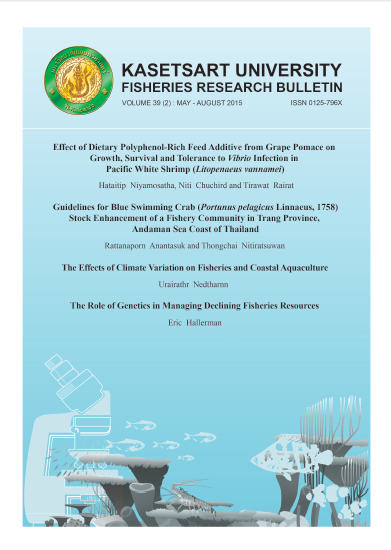The Effects of Climate Variation on Fisheries and Coastal Aquaculture
Main Article Content
Abstract
The two-part study was conducted to ascertain the effect of climate variation on growth of key aquaculture species, i.e. mud crab raised as soft-shell crab, and phytoplankton, a key food source for shellfish. Data were collected from the districts Khlung, Laemsing and Thamai, Chantaburi Province, Thailand, using structured questionnaire, to determine the effect of climate variation on coastal fisheries. The first part of the study showed that sea temperature could significantly alter the growth rates of both mud crab and phytoplankton (p<0.05). The optimal temperature for mud crab growth was between 30 and 33oC, whereas growth rate of phytoplankton was highest with a shortest doubling time at 30oC. However, if the temperature exceeded 32oC, plankton population decreased with the rate declining with cascading effects on shellfish growth. The second part of the study revealed that fishers and aquaculture farmers perceived that climate variation affected their livelihoods including fisheries and aquaculture production. These climate variations included raining during non-rainy season, increased rain fall, severe waves, and changes in monsoon timing. In order to deal with climate variation events, fishing communities should listen to news regarding the weather before making decisions and should exchange information within their communities. Additionally, the government should develop an effective method for forecasting weather, rainfall, and freshwater runoff, and communication channels should be improved.
Article Details
References
2. Badjeck, M. C., H. E. Allison, A. S. Halls, and N. K. Dulvy. 2009. Impacts of climate variability and change on fishery-based livelihoods. Marine Policy. 34: 375-383.
3. Chen, Jiann-Chu and Chia, Peng-Gek. 1996. Hemolymph ammonia and urea nitrogenous excretions of Scyll serrata at different temperature and salinity levels. Marine Ecology Progress Series. 139: 119-125.
4. Chinvanno, S. and A. Snidvongs. 2007. “Assessment of impact, vulnerability and adaptation to climate change: lessons learned from pilot study in the lower Mekong River region during 2003 – 2006”. SEA START RC Technical Report. Southeast Asia START Regional Center. Chulalongkorn University. Thailand.
5. Department of Fisheries. 2010. Fisheries Statistics of Thailand 2010 (Online). Cited in May 2013, www.fisheries.go.th/it-stat/yearbook (In Thai).
6. Department of Marine and Coastal Resources. 2011. Central Database System and Data Standard for Marine and Coastal Resources: Coastal erosion (Online). Cited in May 2011, www.dmcr.go.th/marinecenter/erosion-chan.php (In Thai).
7. Kantungkul, Piti, A. Kamlang-Ek, K. Patthananurak, S. Adjimangkunl, S. Meksumpun, U. Nedtharnn and S. Srisomwong. 2012. Impacts of Climate Variability on Economic Marine Organism Growth. Final draft report of research project (In Thai).
8. Karvonen, A., P. Rintamäki, J. Jokela, and T. E. Valtonen. 2010. Increasing water temperature and disease risks in aquatic systems: Climate change increases the risk of some, but not all, diseases. International Journal for Parasitology. 40: 1483-1488.
9. Organisation for Economic Co-operation and Development. 2010. The Economics of Adapting Fisheries to Climate Change (Online). Cited in May 2012, http://browse.oecdbookshop.org/oecd/pdfs/product/5310041e.pdf
10. Ministry of Natural Resources and Environment. 2013. Environmental Database of Eastern Thailand (Online). Regional Environmental Office 13, Ministry of Natural Resources and Environment. Cited in May 2013, http://www.reo13.go.th/data_envi.html (In Thai).
11. Srisomwong, Jantra. 2003. Potential of Shellfish Culture Areas at Wain Estuary, Chanthaburi and Trat Provinces. M.S. Thesis, Kasetsart University (In Thai).
12. Thai Meteorological Department. 2010. Thailand Annual Weather Summary, 2009 (Online). Cited in May 2010, http://www.tmd.go.th/programs/uploads/yearlySummary/weather2552.pdf (In Thai).
13. Thompson, S., K. 1992. Sampling. New York: Wiley. 343pp.


